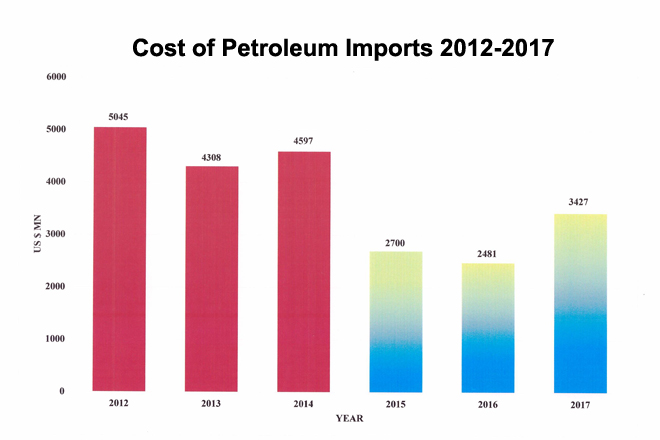Increase in fuel prices and economic mismanagement
Following the recent increase in fuel prices, transport costs and the prices of goods and services have started rising. Fishermen are up in arms against the sudden increase in the price of kerosene by more than double the earlier price and the creation of a coupon system to distribute subsidized kerosene. In the midst the agitation and unrest resulting from this fuel price increase, members of the government have been trying to justify it by saying that fuel costs were higher during the Rajapaksa government. Today the price of a barrel of crude oil is around 70 USD. When I assumed office as President back in November 2005, it was around USD 73. It reached the highest point of USD 160 in June 2008 and even as late as August 2014, the price was over USD 103. It was only in the last three months of 2014 that oil prices started declining and by the time the government changed in January 2015, it had gone down to USD 51 per barrel.
From that point onwards, oil prices remained at a low level for three years. The prices kept declining and reached a low of USD 33 by February 2016. Thereafter oil prices increased slowly but even as late as October 2017, it was less than USD 55. It is only in the last few months that oil prices have steadily risen to reach the present level of USD 70. During the nine full years in which I ruled the country we never had the benefit of low oil prices. The present price of USD 70 per barrel is quite low compared to the average price of crude oil during my government. Despite the highest global crude oil prices in history during those years, we not only won the war against terrorism which many people thought was unwinnable, but also successfully concluded the biggest infrastructure building programme ever seen in this country since the colonial era. We were able to do all that while maintaining the fertilizer subsidy so as to shield farmers from the increasing prices of fertilizer. Despite high oil prices, my government was able to maintain the highest growth rates in Sri Lanka’s history and the per capita GDP increased threefold during my tenure in power.
The yahapalana government has had the benefit of very low crude oil prices and savings totaling more than USD five billion were made in foreign exchange over the past three years. Yet the economy has been in steady decline and development work ceased completely during that period. Last Saturday, the present finance minister said that if he had been holding that position in January 2015, he would not have given concessions to win ‘applause from the gallery’. Thereafter a UNP backbencher echoed much the same views. The reference made by the minister to ‘concessions given to win applause from the gallery’ was probably to the Rs.10,000 allowance for government servants and the reduction in the prices of fuel, gas and certain foodstuffs that were made by this government soon after winning the presidential election. All these were in fact pledges given in Maithripala Sirisena’s presidential election manifesto to win votes.
What they told the people was that all these concessions can be given once the Rajapaksa’s were ousted and corruption was stopped. After winning the Presidential election, they carried out the pledges given in order to win the Parliamentary elections that were to soon follow. What we are seeing now is the result of using government finances for political purposes. Any government can give any concession they like to win elections. What usually acts as a restraint in this regard is the question as to how they are going to find the money to fulfill those commitments after winning. The present government thought only of winning the election – not about what happens afterwards. Having committed public funds to win elections, this government then began the biggest borrowing spree in Sri Lanka’s history to meet the increased expenditure. From January 2015 to date, this government has borrowed a total of around USD 19.5 billion in foreign currency commercial loans and well over six trillion in Rupee loans. Even though the Prime Minister claims at every gathering he addresses that the present economic situation is due to the project loans taken by my government, it is really due to the short and medium term consumption loans taken by the present government.
According to the finance ministry, the foreign currency loans that have to be repaid in 2019 alone amounts to USD 4.2 billion. That is much more than the combined cost of all three phases of the Norochcholai coal power plant, the two phases and bunkering facility of the entire Hambantota port, the Southern highway up to Godagama, the Colombo-Katunayake highway, and the Mattala airport all put together. Members of the public may have noticed that when the Indian Oil Company increased the price of petrol by Rs. 9 per liter, the Ceylon Petroleum Corporation increased the price by more than twice that. Today even at USD 70 a barrel, world crude oil prices are much lower than they were when I was in power and the government can provide fuel at a lower cost by reducing the tax on petroleum products. But that is unlikely to happen because the yahapalana government needs the money to pay for the concessions given to win the last presidential and parliamentary elections. When power hungry politicians literally pledge the Treasury as collateral to achieve their political goals, it is the people of the country who will finally have to pay the price.
online pharmacy
diflucan no prescription
Mahinda Rajapaksa
Former President of Sri Lanka
(MEDIA RELEASE)


